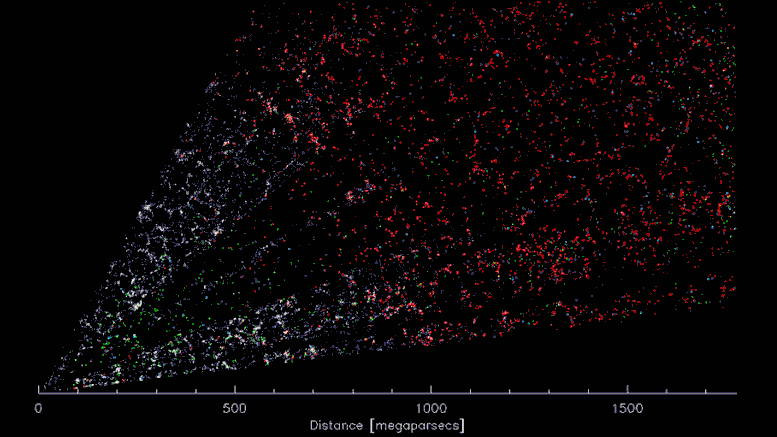
Schlegel/Berkeley Lab using data from DESI.
The Dark Energy Spectroscopic Instrument (DESI) has capped off the first seven months of its survey run by smashing through all previous records for three-dimensional galaxy surveys, creating the largest and most detailed map of the universe ever.Once completed, that phenomenally detailed 3D map will yield a better understanding of dark energy, and thereby give physicists and astronomers a better understanding of the past – and future – of the universe.
Meanwhile, the impressive technical performance and literally cosmic achievements of the survey thus far are helping scientists reveal the secrets of the most powerful sources of light in the universe.
The instrument saw first light in late 2019.
A slice through the 3-D map of galaxies from the first few months of the Dark Energy Spectroscopic Instrument (DESI; right).The earth is at the center, with the furthest galaxies over 10 billion light years away.
This 2D slice of the 3D DESI map shows only about 800,000 of the 7.5 million galaxies currently surveyed, which is itself just a fraction of the 35 million galaxies that will be in the final map.
Schlegel/Berkeley Lab using data from DESI.
And you have to position each robot to collect the light from galaxies billions of light-years away.
By breaking down the light from each galaxy into its spectrum of colors, DESI can determine how much the light has been redshifted – stretched out toward the red end of the spectrum by the expansion of the universe during the billions of years it traveled before reaching Earth.
A new quasar discovered using DESI gives a glimpse of the universe as it was nearly 13 billion years ago, less than a billion years after the Big Bang.Today, about 70% of the content of the universe is dark energy, a mysterious form of energy driving the expansion of the universe ever faster.
As the universe expands, more dark energy pops into existence, which speeds up the expansion more, in a cycle that is driving the fraction of dark energy in the universe ever upwards.
Dark energy will ultimately determine the destiny of the universe: will it expand forever.
Answering these questions means learning more about how dark energy has behaved in the past – and that’s exactly what DESI is designed to do.
In the meantime, DESI is already driving breakthroughs in our understanding of the distant past, more than 10 billion years ago when galaxies were still young.
Pucha and her colleagues are using DESI data to understand the behavior of intermediate-mass black holes in small galaxies.In large galaxies, AGNs are among the brightest objects in the known universe.
The spectra taken by DESI can help solve this problem – and its wide reach across the sky will yield more information about the cores of small galaxies than ever before.
Quasars are excellent probes of the early universe because of their sheer power; DESI’s data will go back in time 11 billion years.
Fawcett and her colleagues are using DESI data to understand the evolution of quasars themselves.DESI is changing that, finding more quasars than any prior survey, with an estimated 2.4 million quasars expected in the final survey data.
The survey has already cataloged over 7.5 million galaxies and is adding more at a rate of over a million a month.
In November 2021 alone, DESI cataloged redshifts from 2.5 million galaxies.
By the end of its run in 2026, DESI is expected to have over 35 million galaxies in its catalog, enabling an enormous variety of cosmology and astrophysics research.
National Science Foundation, the Science and Technologies Facilities Council of the United Kingdom, the Gordon and Betty Moore Foundation, the Heising-Simons Foundation, the French Alternative Energies and Atomic Energy Commission (CEA), the National Council of Science and Technology of Mexico, the Ministry of Economy of Spain, and by the DESI member institutions